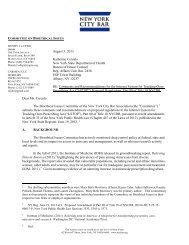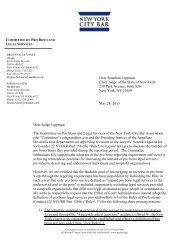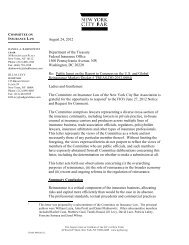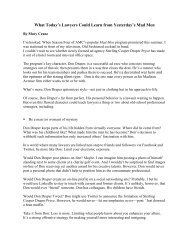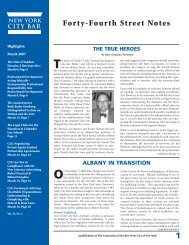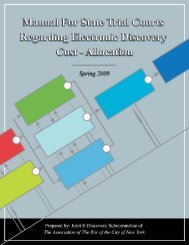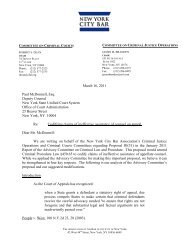2007 Issue 1 - New York City Bar Association
2007 Issue 1 - New York City Bar Association
2007 Issue 1 - New York City Bar Association
You also want an ePaper? Increase the reach of your titles
YUMPU automatically turns print PDFs into web optimized ePapers that Google loves.
L A W Y E R ’ S R O L E I N C O R P O R A T E G O V E R N A N C E<br />
fort to impede an SEC investigation may itself become the subject of an<br />
enforcement proceeding.” 45 And, on multiple occasions, Cutler stressed<br />
that the “integrity of the investigative process” is sacred and a complementary<br />
goal to cooperation. 46 Former SEC General Counsel Prezioso has<br />
also warned that independent investigations “are worse than useless if<br />
conducted ineffectively.” 47<br />
3. Sanctions<br />
Coupled with this evolving expectation of cooperation is the SEC’s<br />
escalation of the level of monetary penalties. In an April 2004 speech,<br />
Cutler explained that the SEC’s approach to fines had changed: “We’re<br />
clearly in the midst of an evolution, if not a revolution in thinking. In a<br />
decade, we’ve gone from a regime in which monetary penalties were imposed<br />
only rarely to one in which large penalties seem to be part of virtually<br />
all significant settlements.” 48 He also noted that the SEC now “start[s]<br />
with the presumption that any serious violation of the federal securities<br />
laws should be penalized with a monetary violation.” 49 While sanctions<br />
of more than $10 million were considered large only a few years ago,<br />
hundred-million-dollar penalties are now not uncommon. Thus, the incentives<br />
to cooperate, and the costs of not cooperating have increased<br />
dramatically.<br />
On January 4, 2006, acting unanimously, the SEC issued a Statement<br />
Concerning Financial Penalties, setting forth the factors it will consider<br />
in deciding whether and how to impose penalties in enforcement actions<br />
against corporations. 50 The Statement identifies two principal considerations<br />
that will guide the SEC’s determination whether a corporate penalty<br />
is appropriate: (1) [t]he presence or absence of a direct benefit to the<br />
corporation as a result of the violation, and (2) the degree to which the<br />
penalty will recompense or further harm the injured shareholders.<br />
45. Kathleen Day, SEC Gets Tough on Hindering Investigations, Wash. Post, Mar. 19, 2004,<br />
at E1 (quoting Cutler).<br />
46. Cutler, UCLA Speech, p. 49 in Report above; see also Cutler, Remarks Before D.C. <strong>Bar</strong>,<br />
n.177 in Report above.<br />
47. Prezioso, Vanderbilt Remarks, n.176 in Report above.<br />
48. Stephen M. Cutler, Speech at 24th Annual Ray Garrett Jr. Corporate & Securities Law<br />
Institute (Apr. 29, 2004), available at http://www.sec.gov/news/speech/spch042904smc.htm.<br />
49. Id. (emphasis added).<br />
50. SEC Press Release No. 2006-4, Statement of the Securities and Exchange Commission<br />
Concerning Financial Penalties, available at http://www.sec.gov/news/press/2006-4.htm.<br />
2 0 0 7 V O L. 6 2 , N O. 1<br />
219



